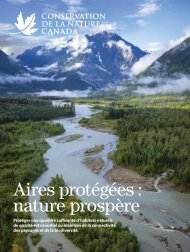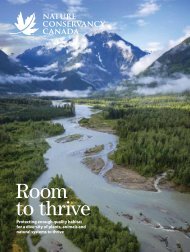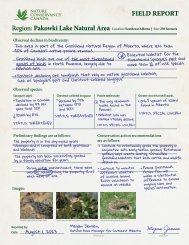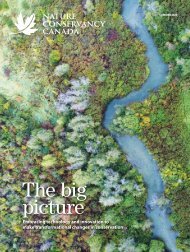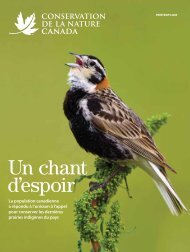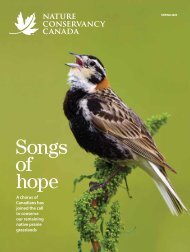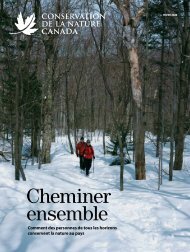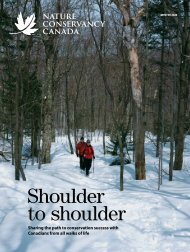NCC Magazine: Winter 2022
Create successful ePaper yourself
Turn your PDF publications into a flip-book with our unique Google optimized e-Paper software.
Looking ahead<br />
A strong workforce of young adults (those aged 18–35)<br />
is a strategic advantage because it helps us focus on<br />
tomorrow, take bolder actions, think innovatively and<br />
consider long-term impacts, says <strong>NCC</strong>’s president and<br />
CEO, Catherine Grenier.<br />
“When you have a young cohort working with you, it<br />
allows you to glance at what the future’s going to look<br />
like,” says Grenier. “In the nature conservation field, it’s<br />
important to have all demographics represented, but<br />
especially young adults, because they’re the ones who<br />
will see the benefits of the work we are doing now in<br />
five, 10, 15, 25 years.”<br />
If you look back at <strong>NCC</strong>’s big accomplishments from<br />
the last while, there have been young people involved in<br />
almost every one,” says Megan Lafferty, <strong>NCC</strong>’s manager<br />
of land protection measures. “For example, young staff<br />
led the Vidal Bay project, our largest to date in Ontario.<br />
From fundraising to closing projects, many young staff<br />
were instrumental in the success of our Landmark<br />
Campaign. And they are pushing us to do more, better.”<br />
Lafferty has joined Grenier for today’s interview<br />
about young people leading the way in conservation.<br />
The joint interview is a subtle, but important, signal<br />
that shows <strong>NCC</strong>’s youthful advantage is not by accident,<br />
but by design. Lafferty, 32, heads up a taskforce of<br />
young staff entrusted with making recommendations<br />
to <strong>NCC</strong>’s management, using the “by youth, for youth”<br />
approach, well-understood as a prerequisite for<br />
meaningful youth engagement.<br />
Young people know what young people need,<br />
Lafferty says, and when they lead with a clear purpose,<br />
it injects their fresh perspectives and unique values<br />
into conservation efforts.<br />
“Young people today think more about social impact and<br />
take a more comprehensive look at their actions and their<br />
consequences, as well as the interconnectedness of the<br />
things we do,” says Lafferty, “We’re seeing more and more<br />
how interconnected the challenges we’re facing are with<br />
climate change and biodiversity. Supporting young people<br />
who have that interconnected vision is important if we want<br />
to address those challenges.” Added to that, Lafferty says,<br />
is that today’s youth leaders are tomorrow’s world leaders.<br />
“In the climate and biodiversity space, youth are not<br />
tomorrow’s leaders, they’re the only leaders,” challenges<br />
James Bartram, president of the Canadian Committee<br />
for the International Union for Conservation of Nature<br />
(CCIUCN). It’s a bold statement from someone who is<br />
a strong supporter of intergenerational learning, where<br />
people of all ages learn together and from one another.<br />
But Bartram’s statement is not meant to undermine the<br />
contributions of previous generations. Instead, he credits<br />
young people for having mainstreamed climate change in<br />
global conversations, and says the same will only happen<br />
for biodiversity if youth are educated, equipped and empowered<br />
to lead. To help young adults advance their conservation<br />
leadership, CCIUCN has for many years hosted<br />
a Youth Ambassador Program, while their Young Professionals<br />
in Canadian Conservation Network is a one-thousand-member-and-growing<br />
inclusive virtual network raising<br />
up the voices of young conservation leaders.






